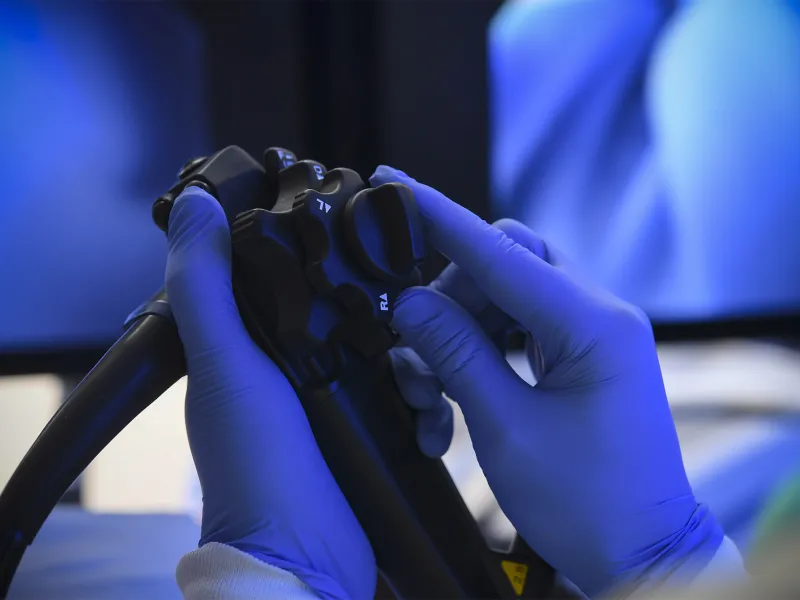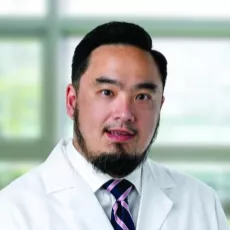
More Advanced Approaches Mean Faster Healing
At the Center for Interventional Endoscopy, we’re committed to advancing our care through adopting innovative approaches to endoscopy — all for our patients’ total healing.
Third space endoscopy, also commonly referred to as submucosal endoscopy, encompasses several endoscopic procedures that use the submucosal space to access deeper layers of tissue in the gastrointestinal (GI) tract.
With these and other third space endoscopy procedures, our team can take a minimally invasive approach to treating illnesses that were once only treated through open surgery.

Meet Dr. Dennis Yang, Director of Third Space Endoscopy
Dennis Yang, MD, is the Director of Third Space Endoscopy at the Center for Interventional Endoscopy at AdventHealth Orlando and Professor of Medicine at Loma Linda University Health.
Dr. Yang is an award-winning physician for excellence in clinical research, mentorship and teaching. He also holds multiple positions within esteemed organizations, including the American Gastroenterological Association, the Florida Gastroenterological Society and the Gastrointestinal Endoscopy Editorial Board.
His main clinical interests are in minimally invasive interventional endoscopic procedures (including POEM and G-POEM) to treat motility disorders and advanced resection techniques (like EMR and ESD) to treat early gastrointestinal cancers.
Specializing in Third Space Endoscopy Procedures
Complex digestive disorders call for specialized and innovative approaches. That’s why our experienced surgeons perform these third space endoscopy procedures to help you feel whole again. Learn what each of these procedures treat, what’s involved and what to expect.
- Esophageal Peroral Endoscopic Myotomy (E-POEM)
-
Esophageal peroral endoscopic myotomy (E-POEM) is a minimally invasive third space endoscopic procedure that treats esophageal motility disorders.
Esophageal motility disorders are a group of illnesses that affect the esophagus and the way food is transferred from your mouth to your stomach. Some common ones include achalasia, jackhammer esophagus, diffuse esophageal spasm and esophagogastric junction outlet obstruction (EGJOO).
E-POEM is an alternative to surgical Heller myotomy for esophageal motility disorders, and it may be an option for people who have persistent or recurrent symptoms after a previous surgical procedure.
Evaluation of Esophageal Motility Disorders
Your physician may conduct a series of tests to diagnose your digestive problems. These tests may include:
- Standard upper endoscopy
- High-resolution esophageal manometry
- Radiographic tests (like a barium swallow)
- Endoflip
E-POEM is a good option for some patients but not everyone. Your physician may evaluate you in our clinic to discuss treatment options and determine if E-POEM may be right for you.
How Is the E-POEM Procedure Performed?
E-POEM is performed similarly to a standard upper endoscopy by an experienced advanced endoscopist who is specifically trained in third space endoscopy. The procedure is performed under general anesthesia and generally takes an hour to an hour and a half to complete.
Once you are under anesthesia, the physician uses a thin, flexible endoscope to navigate into your throat. Then, a superficial incision is made within the esophagus and a tunnel is created between the layers of the esophagus to reach the tight esophageal sphincter. A permanent cut (called a myotomy) of the sphincter muscle is then performed to help food pass into the stomach more easily.
After Your E-POEM Procedure
This procedure is routinely performed on an outpatient basis, although your physician may elect to admit you for an overnight stay in the hospital for monitoring. Nausea and pain medications are sometimes needed, but most patients have no symptoms 24 to 48 hours after the procedure. Your physician may order imaging tests to ensure the surgical area is intact before you can start a diet.
Going Back Home and to Work
After your procedure, you’ll complete a short course of antibiotics to prevent infection. Your diet will progress to a soft diet after the first three days following your E-POEM procedure, and then you can advance your oral intake as tolerated. You may resume all home medications unless otherwise instructed by your physician.
- Gastric Peroral Endoscopic Myotomy (G-POEM)
-
Gastric peroral endoscopic myotomy (G-POEM) is an innovative minimally invasive endoscopic technique to treat gastroparesis, a motility disorder that causes the stomach to empty slowly and food to not move properly into the small intestine.
Evaluation of Gastroparesis
Your physician may conduct a series of tests to diagnose your digestive problems. These tests may include:
- Standard upper endoscopy
- Radiographic tests
- Gastric emptying study
- EndoFLIP
G-POEM is a good option for some patients but not everyone. Your physician may evaluate you in our clinic to discuss treatment options and determine if G-POEM may be right for you.
How Is the G-POEM Procedure Performed?
G-POEM is performed in a similar fashion to a standard upper endoscopy by an experienced advanced endoscopist who is specifically trained in third space endoscopy. The procedure is performed under general anesthesia and generally takes an hour to an hour and a half to complete.
Once you are under anesthesia, the physician uses a thin, flexible endoscope to enter your throat and stomach. Then, a superficial incision is made within the stomach and a tunnel is created between the layers of the stomach to reach the pyloric sphincter. A permanent cut (called a pyloromyotomy) of the sphincter muscle is then performed to facilitate the easier passage of food into the small intestine.
After Your G-POEM Procedure
This procedure is routinely performed as an outpatient visit, although your physician may elect to admit you for an overnight stay in the hospital to monitor you. Nausea and pain medications are sometimes needed, but most patients have no symptoms 24 to 48 hours after the procedure. Your physician may order imaging tests to ensure the surgical area is intact before you can start a diet.
Going Back Home and to Work
You’ll complete a short course of antibiotics following your procedure to prevent infection. Your diet will progress to a soft diet after the first three days following your G-POEM procedure, and you can then advance your oral intake to a gastroparetic diet. You may resume all home medications unless otherwise instructed by your physician.
- Treatment of Esophageal Diverticuli
-
Flexible endoscopic techniques encompass an array of endoscopic procedures that treat symptomatic esophageal diverticuli. These advanced endoscopic techniques are minimally invasive alternatives to conventional surgery.
What Is an Upper Esophageal Diverticulum?
Zenker’s refers to an outpouching or herniation of the esophagus, just below the upper esophageal sphincter.
Evaluation of an Upper Esophageal Diverticulum
Your physician may conduct a series of tests to diagnose your digestive problems. These tests may include a standard upper endoscopy or radiographic tests (barium swallow).
Flexible endoscopic intervention for your esophageal diverticulum is a good option for some patients but not everyone. Your physician may evaluate you in our clinic to discuss treatment options and determine if this may be the best choice for you.
How Is the Procedure Performed?
Treatment of Zenker’s diverticuli is performed in a similar fashion to a standard upper endoscopy by an experienced advanced endoscopist who is specifically trained in third space endoscopy. The procedure is performed under general anesthesia and generally takes half an hour to complete.
Once you are under anesthesia, the physician uses a thin, flexible endoscope to enter your throat. The physician will then use different types of electrosurgical knives to cut the cricopharyngeal muscle (septum) of the diverticulum.
After Your Procedure
Your physician may elect to admit you for an overnight stay in the hospital to monitor you. They may also order imaging tests to ensure the surgical area is intact before you can start a liquid diet.
Going Back Home and to Work
You will complete a short course of antibiotics following your procedure to prevent infection. Your diet will progress to a soft diet after the first three days following your procedure, and you can then advance your diet as tolerated. You may resume all home medications unless otherwise instructed by your physician.
- Endoscopic Submucosal Dissection (ESD)
-
ESD is a minimally invasive endoscopic procedure performed to remove lesions from the GI tract. As opposed to surgery, ESD permits the excision of GI lesions without requiring organ resection.
What Are Common Indications of ESD?
ESD indicators include:
- GI polyps in the esophagus, stomach, duodenum, colon and rectum
- GI-based cancers, including those arising from Barrett’s Esophagus and early tumors of the esophagus, stomach, colon or rectum with minimal or no risk of cancer spreading
How Is ESD Performed?
ESD is performed in a similar fashion to a standard upper endoscopy or colonoscopy by an experienced advanced endoscopist who is specifically trained in third space endoscopy. The procedure is performed under moderate or general anesthesia.
Once you’re under anesthesia, the physician inserts the endoscope through your mouth or anus, depending on the location of the lesion. Once the lesion is identified, the physician will use an electrosurgical knife to remove any precancerous or cancerous tissue from the GI wall until complete removal is confirmed endoscopically.
The resected specimen will be removed from the body through the endoscope and sent to a laboratory for examination. This last step may take several days before results are available.
After Your ESD Procedure
This procedure is routinely performed on an outpatient basis, although your physician may elect to admit you for an overnight stay in the hospital to monitor you.
Going Back Home and to Work
Antibiotics are generally not required following the ESD procedure. Individualized dietary and medication instructions based on the ESD site in the GI tract will be provided to you before you leave.
- Other Procedures
-
Our team at the Center for Interventional Endoscopy offers groundbreaking minimally invasive endoscopic therapeutic options for a variety of other disorders that were previously treated only with conventional surgery.
These highly specialized techniques include submucosal tunneling endoscopic resection (STER) and full-thickness endoscopic resection (FTER) of GI-based tumors.
